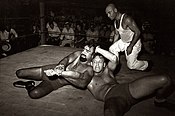This article needs additional citations for verification. (May 2007) |
| Part of a series on |
| Professional wrestling |
|---|
 |
Professional wrestling in the United States, until the 1920s, was viewed as a legitimate sport. This view did not endure into the 1930s, as professional wrestling became identified with modern theatrics. The scripted nature of the art has made some critics view it as an illegitimate sport, particularly in comparison to boxing, mixed martial arts, and amateur wrestling. No major promoter or wrestler denies that modern professional wrestling has predetermined match outcomes.[1][2][3] Despite this, promoters and fans continued to play along with the tradition of viewing the matches as legitimate competition; this has become a tradition known as "kayfabe".
Through the advent of television in the 1950s and cable in the 1980s, professional wrestling began appearing in powerful media outlets, reaching never before seen numbers of viewers. It became an international phenomenon with the expansion of the World Wrestling Federation (WWF). Throughout the 1990s, professional wrestling achieved highs in both viewers and financial success during a time of fierce competition among competing promotions, such as WWF, World Championship Wrestling, and Extreme Championship Wrestling.
The nature of professional wrestling changed dramatically to better fit television, enhancing character traits and storylines. Television also helped many wrestlers break into mainstream media, becoming influential celebrities and icons of popular culture. In the United States, in the First Golden Age of professional wrestling in the 1940s–1960s, Gorgeous George gained mainstream popularity, followed in the Second Golden Age in the 1980s–early 1990s by Hulk Hogan, André the Giant, "Macho Man" Randy Savage, Ric Flair, "Rowdy" Roddy Piper, Ultimate Warrior, Sting, Dusty Rhodes, Bret "The Hitman" Hart, Shawn Michaels, and The Undertaker, and in the Third Golden Age of the mid-1990s–early 2000s by the likes of "Stone Cold" Steve Austin, The Rock, and Triple H.
- ^ HESTER, MATTHEW. "The History of Pro Wrestling In The U.S (Part 1)". Www.syndication.bleacherreport.com. Retrieved December 14, 2022.
- ^ HESTER, MATTHEW. "The History Of Pro Wrestling In The U.S (part 2)". Www.syndication.bleacherreport.com. Retrieved December 14, 2022.
- ^ Dellinger, Bob. "Wrestling in the USA". Nwhof.org. Retrieved December 14, 2022.
© MMXXIII Rich X Search. We shall prevail. All rights reserved. Rich X Search
